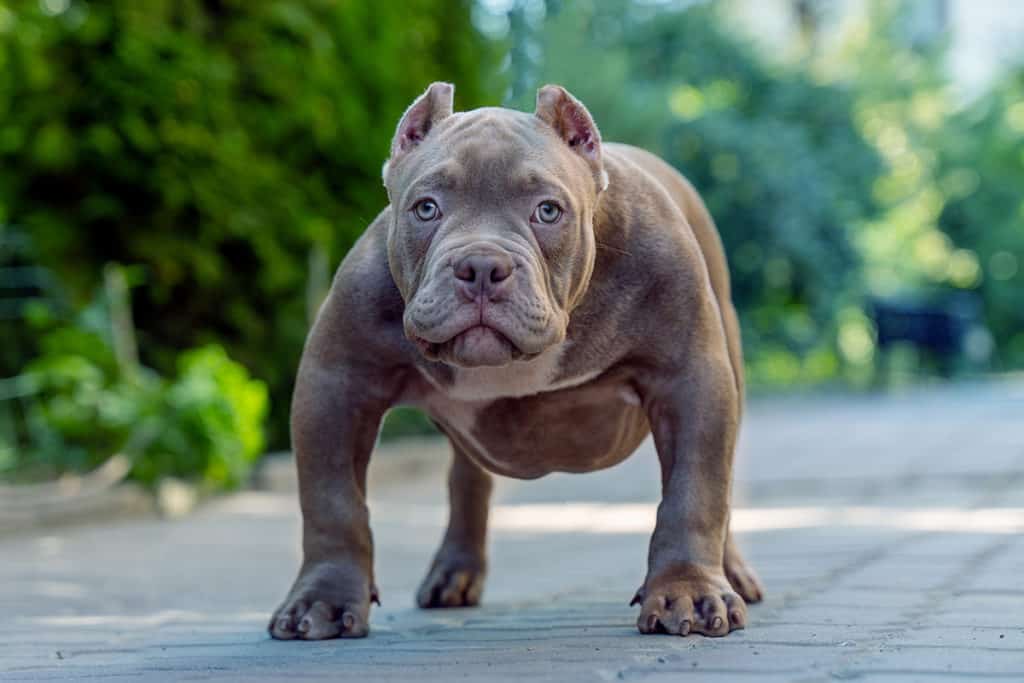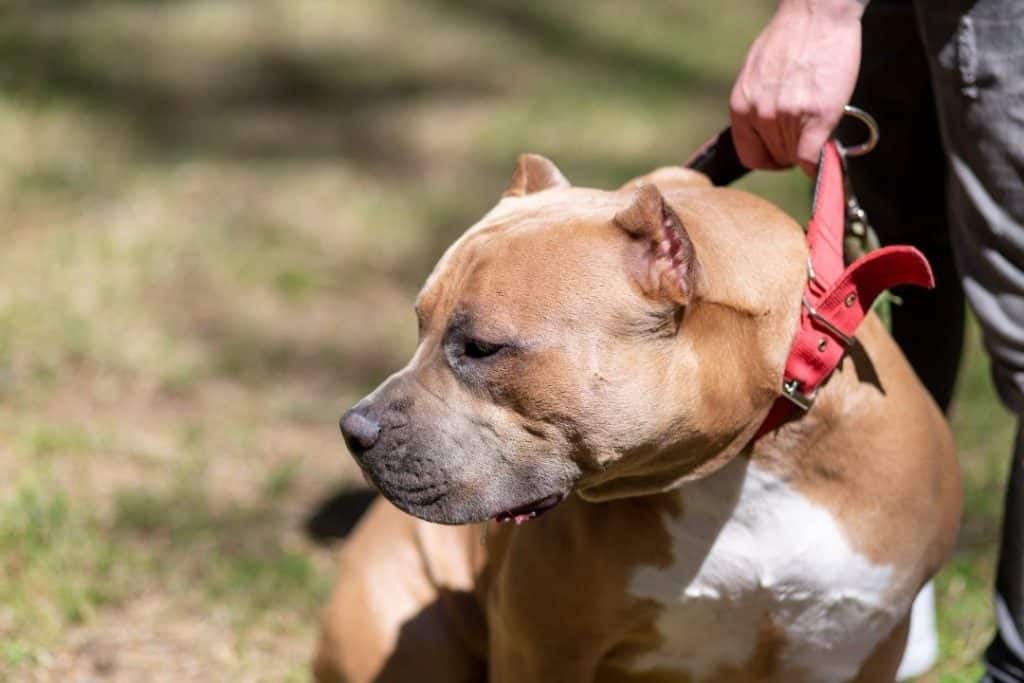This article may contain affiliate links, and I will be compensated if you make a purchase after clicking on my links (at no additional cost to you)
Choosing to raise a bully breed is no easy task. They can be quite the handful if you don’t know what you’re doing.
Understanding the differences between the different breeds is crucial to give your dog the best outcome.
What is the difference between an exotic american bully and a standard american bully?
The Exotic Bully breed is smaller, closer to the ground, and has a medium to low energy level compared to the American Bully — they’re a newer breed. As for the American Bully, it has a taller stature and is typically muscular. Both breeds are great family dogs but require many activities.
Whether you’re just venturing into the bully breeds or an experienced owner, you can learn all sorts of new things about the difference between the breeds by reading on.
Exotic Bully
The Exotic Bully is a relatively young variation on the American Bully. The American Kennel Club (AKC) has not formally recognized the breed, so technically, it’s a ‘designer breed.’ This breed has many distinctive bully traits but smaller, more exaggerated forms.
Exotic Bullies Are Smaller Than American Bullies
However, since the Exotic Bully breed is still developing and was first recognized by a breed organization in 2008, there’s little consistency outside of what I explained above. The size and general stature are the primary breed signifiers.
Here are some of the defining physical characteristics of Exotic Bullies:
- Exotic Bullies tend to have a smaller, broader stature than American Bullies.
- They have exaggerated features and should look distinct from other bully breeds.
- Most should be under 16.5 inches (42 centimeters) tall.
- Like other bully breeds, some may have cropped ears.
- Exotic Bullies should be around 30 to 50 pounds (13.6 to 22.7 kilograms).
Exotic Bullies Are Energetic But Not Very Athletic
Exotic Bullies are high-energy dogs and need a lot of exercise. Their high energy has a lot to do with their weight management and keeping them from becoming destructive.
Owners should not leave their Exotic Bullies alone all day. These dogs need a significant amount of exercise and owner involvement. You can’t just leave these dogs in the backyard for a couple of hours; you’ll need to take them to the park or on long walks.
That said, Exotic Bullies are also not marathon dogs. They won’t join you on your multi-mile runs, but they can keep up with jogs around the block.
Patience Is Important When Training Exotic Bullies
Bully breeds, in particular, are motivated by rewards like treats. They also do well with clicker training. Since bully breeds can be more stubborn, training them takes time and care.
You need to stay positive and reinforce good behavior no matter which training you use. Even if you end the training session feeling frustrated, you should continue to praise your dog for its hard work.
You should never physically punish your dog. Not only could you end up hurting your dog, but physical punishments may make your dog deeply scared. Fear will quickly lead to aggression or shyness.
Careful correction is the best way to help your dog learn constructively. Instead of reaching for the rolled-up newspaper after your dog chewed up your shoes, analyze the situation. If your dog has chewing issues, you should invest in alternatives to chew.
Just like any other dog, bully breeds need redirection of energy, especially if they have become destructive in some way. If you meet your dog with constructive corrections, they’ll respond positively.
Exotic Bullies Are Prone to Weight Gain
Since Exotic Bullies are very energetic dogs, they can eat a lot. The average Exotic Bully should eat about 2 cups (480 mL) of food daily. It would help if you also looked at your dog food manufacturer’s guidelines for how much to feed by weight.
The Exotic Bully can be prone to weight gain from overeating, but with regular exercise, you can keep your dog at a healthy weight.
Exotic Bullies Are Great for Families
Exotic Bullies love families and get along great with kids like other bully breeds. They need to be properly socialized, but you’ll have a great dog who will get along with most once that is done. Though they might seem intimidating, they can be very friendly.
American Bully

The American Bully is another newer member of the overarching bulldog family. They have been being developed for longer, first recognized by the American Bully Kennel Club in 2004. They’re sturdy and friendly dogs.
American Bullies Come in Various Sizes
While the American Bully has not been AKC recognized, there are several defining characteristics that other bully breed associations agree are standard. While you can’t show your American Bully, you can use these to ensure your dog is well-bred.
There are several distinctive physical features of the American Bully:
- The American Bully should be a taller dog with a broad stance, but they come in several sizes.
- They can either have cropped ears or long, but they should have the typical wrinkles and prominent cheeks that are standard in the bully breeds.
- These dogs come in a whole host of colors and patterns.
- They also should be no more than 20 inches (about 50 centimeters) tall.
- American Bullies can range from as little as 40 pounds to 130 pounds (18 to 59 kilograms).
American Bullies Can Be More Energetic Than Exotic Bullies
Like other members of the bully breeds, American Bullies tend to have a lot of energy. This energy can be a lot for anyone to handle, and they have a higher energy level than Exotic Bullies.
However, make sure to pay attention to how your dog is doing with the exercise. Don’t push your dog too far, or you’ll risk injury. Bullies can struggle with hip dysplasia, but careful monitoring will help keep your dog happy and healthy.
American Bullies Are As Trainable as Exotic Bullies

As I mentioned above, reward-based training is the most effective way to train bully breeds. Consistency, a positive attitude, and dedication to proper training will give you the best-behaved dog on the block.
American Bullies, in particular, like their Exotic Bully cousins, need to be patiently trained.
Another critical thing about bully breeds is that they can be amiable dogs when socialized properly. Exposing your dog to sights, sounds, and other animals is vital to help them be a happy and healthy member of doggy society.
American Bullies Require a Lot of Food

Like other bully breeds, American Bullies need a lot of food. On average, they need about four cups (950 mL) of food in one day, which is significantly more than the Exotic Bully.
However, you should also check the food bag for manufacturer specifications based on weight.
My dog OSO is an XL American Bully and has many allergies exacerbated by his food. I have tried many different types of food and diets, but the method that works best for Rudy is grain-free, lamb-based kibble. He’s much happier and more comfortable now that he’s on a diet that works.
If your dog constantly has allergic reactions, you should consider what you feed it. Sometimes, there’s an underlying issue that you can solve by choosing a different formula.
Grain is a widespread allergy in dogs, and most mass-produced dog food uses grain. However, since more awareness is coming to this issue, more and more companies are going grain-free, and there are plenty of options to choose from.
American Bullies Are Great For Families
American Bullies are perfect for families. They’re known for their loyalty and devotion to their families. They can get along with cats and other household pets like most other dogs after being adequately socialized.
American Bullies also tend to be lower energy than other bully breeds, but not as low as the Exotic Bully. They still need a fair amount of daily exercise. These dogs can be a better choice for a busy family on the go. This isn’t a breed that will lay around the house all day.
Final Thoughts
Bully breeds have a lot of similarities, especially when it comes to the Exotic Bully and the American Bully.
However, the American Bully tends to be larger and has less dramatic features, while the Exotic Bully is more petite, stockier, and has more exaggerated features. Both are fantastic family dogs and excellent life-long companions.

I created this blog to share my passion for bullies, and help current and future pitbull owners with things like diet and education.
Hope you find it useful, don’t hesitate to drop a comment on my articles!



